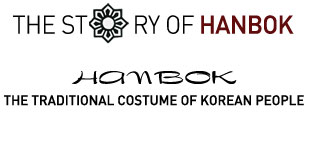
The Hanbok is the traditional outfit of the Korean people. Koreans nowadays wear this outfit only on festive days or special anniversaries, however it was worn daily up until just 100 years ago. It is a kind of traditional formal dress and most Koreans keep a hanbok for these special times. Children wear hanbok on their first birthday and adults wear it for their wedding ceremony and on their 60th birthday. The hanbok is also worn for funerals or religious services, and is still used as casual wear in villages or districts where the traditional ways of life are still maintained such as Chunghak-dong on Mount Jirisan.
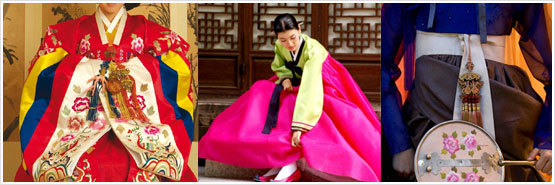
One way to refer to Korea is 'the people in white’, which refers to the fact that the Korean people often wear white or similar tones. Koreans have long worn white clothing made of hemp or cotton regardless of their status. The case of formal dress was different, however. Color and design were typically luxurious and the hanbok was particularly highly valued for its gracious and subtle colors. Modern designers have presented the traditional Korean costume at renowned cities of fashion such as Paris and New York.
The hanbok is colored using natural dyes. The colors of nature are imbued in the cloth. For example, red dye is obtained from the petals of red flowers. The color pigment is extracted by grounding the petals in a mortar, putting them in a jar and rinsing them with hot caustic soda. It is a very slow, complicated, precise process. The colors obtained in this way differ greatly from artificial dyes in their color and depth. The Hanbok is creative and emotional in its design. One Korean phrase regarding the shape of the outfit is the 'upper is narrow, lower is wide'. The jacket must be tightened and the skirt relaxed, as was the silhouette of the women’s hanbok in Joseon times. The tightly fitting jacket attractively reflects the shape of the upper body. The wide sleeves and flexible skirts enhance the wearer’s gracefulness by hiding the physical features of the lower body.
The principles behind the creation of the hanbok can be explained by the movement from 2 dimensions to 3 dimensions. The flat cloth is patterned, cut, and sewn in 2 dimensions but the subject wearing the hanbok is a 3 dimensional being. The hanbok is frilled or fastened with string to enhance the 3D affect. The unique line of the hanbok is created from this process. The lines of the hanbok costume are as smooth as the curves of the eaves of tiled roof house and as sharp. An old adage says that you can tell the man by his clothes.
Koreans have traditionally lived as one with nature, and obtained all material from natural sources for making cloth and coloring it. Koreans favor smooth curves rather than straight lines and that has added a gracious line to the hanbok. A common comment that every hanbok designer gets is that the outfit is more beautiful when it is worn than when it is on the hanger, and more beautiful when moving than when standing. Indeed, the unique lines of the hanbok appear at their greatest when the wearer is in motion.
Although hanbok have become the ritual dress of choice worn only on traditional holidays, Koreans' love for hanbok is tremendous. The popularity of Korean classic dramas is causing many foreigners to take a keener interest in traditional Korean attire as well.
[Hanbok in the 16th Century]
| 1. Men's hanbok | 2. Women's hanbok |
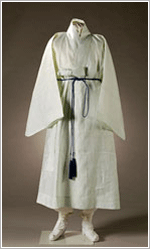 |  |
| 3. Children's hanbok | 4. Ceremonial hanbok |
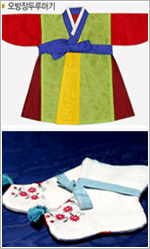 | 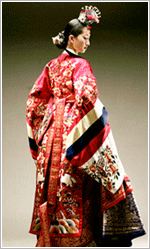 |
[Headgear and Accessories Worn Together with Hanbok]
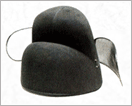 | Samo | | A hat worn together with dalleyong (a robe) by officials as everyday clothes. | |
| |
| Gat | 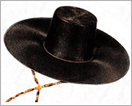 | | A type of hat worn by men in the Joseon Dynasty. It was worn with po (a gown) by officials outside their homes. | |
 | [Nambawi] | | A winter cap worn by both men and women to cover the forehead, upper neck, and ears. Also called pungdaengi. | | | [Bokgeon] |  | | A type of hat worn by men in the Joseon Dynasty. It was worn with po by officials outside their homes. | |  | [Hogeon] | | Headgear worn by boys in the late Joseon Dynasty and the period of modernization. It is similar to bokgeon, but the crown of the head is open and patterns of ears, eyes, and beards are embroidered to show a tiger design. It was usually worn with obangjang durumagi, jeonbok, or sagyusam. | | |
| |
| [Jokduri] | 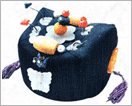 | | A type of crown worn by women to complete a ceremonial dress. It was usually worn together with wonsam (a bride's long overcoat). Hard paper and cotton filling are covered with silk, and a cloisonne ornament is placed on the top. | |
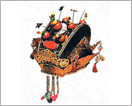 | [Hwagwan] | | A crown worn by women to complete a ceremonial dress. Adorned with butterfly ornaments, five-colored beads, and gold thread, it is more lavish than jokduri and was mostly worn with hwarot or dangui . | |
| [Jobawi] | 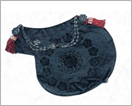 | | A winter cap for women. It is open on the top, and its sides are rounded to fully cover the ears. It was generally made in black silk with tassels hanging on the front and back. Gems sometimes decorate the tassels. Gold gilt or beads were also used for decoration. | |
 | [Gulle] | | Decorative headgear to keep children warm. Mostly worn by both boys and girls aged one year to five years old. For winter use, it was made of black silk. For use in spring/fall, five-colored thin silk was used. Doturak daenggi (a hair ribbon) hangs on the back. | |
| [Ayam] |  | | A winter cap mostly worn by women. It does not cover the ears, and some are lined with fur. A long daenggi hangs on the back, which is called ayamdeurim , and is sometimes decorated with jade or amber. | |
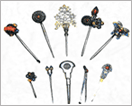 | [Dwikkoji] | | An accessory pinned on knotted hair by women in the Joseon Dynasty. It also had a practical use as it was used as an earpick and a stick to part hair. | |
| [Binyeo] |  | | A rod-like hairpin used to fasten a crown or a wig and hold braided hair up. In addition to the practical use, binyeo had a decorative purpose and indicated the status of the wearer. They were referred to as yongjam, bongjam, jukjam, mokryeokjam, maejukjam , or jukjeoljam depending on the decoration on the top of binyeo . The materials, shapes, sizes, and patterns of binyeo vary greatly. | |
 | [Cheopji] | | An ornament placed on the top of knotted hair when women wore ceremonial dresses. It was often made with silver in the shape of a frog. Long tails were attached on both sides and knotted together with the hair. Royal court ladies used it everyday, but commoners wore it only with ceremonial dress. It also functioned as a fastening for jokduri or hwagwan. | |
| [Daenggi] | 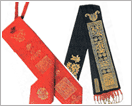 | | A ribbon used to tie and decorate long hair. There are a great variety, including jebiburi daenggi, apdaenggi, doturak daenggi and goidaenggi . | |
 | [Norigae] | | One of the major accessories for women. The norigae pendant was widely used by royal court ladies as well as commoners. It is tied to the outer goreum (a coat string) or the waist of a skirt and gives a luxurious look to the entire outfit. The two major types of pendants are samjak norigae (a pendant with three ornaments) and danjak norigae (a pendant with one ornament). Samjak norigae is again divided into daesamjak and sosamjak . There are many types of norigae , including jangdo, su, hyangnang, horibyeong, samcheonju, baneuljip, and soknorigae. | |
Source : visitkorea.or.kr
 The Hanbok is the traditional outfit of the Korean people. Koreans nowadays wear this outfit only on festive days or special anniversaries, however it was worn daily up until just 100 years ago. It is a kind of traditional formal dress and most Koreans keep a hanbok for these special times. Children wear hanbok on their first birthday and adults wear it for their wedding ceremony and on their 60th birthday. The hanbok is also worn for funerals or religious services, and is still used as casual wear in villages or districts where the traditional ways of life are still maintained such as Chunghak-dong on Mount Jirisan.
The Hanbok is the traditional outfit of the Korean people. Koreans nowadays wear this outfit only on festive days or special anniversaries, however it was worn daily up until just 100 years ago. It is a kind of traditional formal dress and most Koreans keep a hanbok for these special times. Children wear hanbok on their first birthday and adults wear it for their wedding ceremony and on their 60th birthday. The hanbok is also worn for funerals or religious services, and is still used as casual wear in villages or districts where the traditional ways of life are still maintained such as Chunghak-dong on Mount Jirisan.





















No comments:
Post a Comment